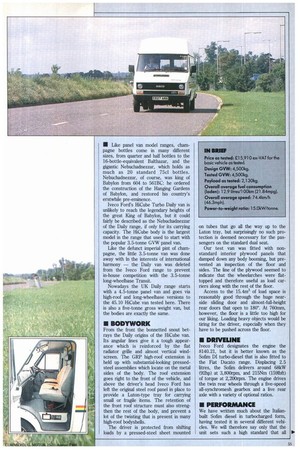DAILY DOS
Page 48

Page 49

If you've noticed an error in this article please click here to report it so we can fix it.
OF POWER
Only four major manufacturers offer panel vans in the 3.5 to 7.5-tonne sector. We complete our tests of the quartet with lveco Ford's high-cube, high-power Turbo Daily 45.1 0.
• Like panel van model ranges, champagne bottles come in many different sizes, from quarter and half bottles to the 16-bottle-equivalent Balthazar, and the gigantic Nebuchadnezzar, which holds as much as 20 standard 75c1 bottles. Nebuchadnezzar, of course, was king of Babylon from 604 to 561BC: he ordered the construction of the Hanging Gardens of Babylon, and restored his country's erstwhile pre-eminence.
Iveco Ford's HiCube Turbo Daily van is unlikely to reach the legendary heights of the great King of Babylon, but it could fairly be described as the Nebuchadnezzar of the Daily range, if only for its carrying capacity. The HiCube body is the largest model in the range that used to start with the popular 3.5-tonne GVW panel van.
Like the defunct imperial pint of champagne, the little 3.5-tonne van was done away with In the interests of international harmony — the Daily van was deleted from the Iveco Ford range to prevent in-house competition with the 3.5-tonne long-wheelbase Transit.
Nowadays the UK Daily range starts with a 4.5-tonne panel van and goes via high-roof and long-wheelbase versions to the 45.10 HiCube van tested here. There is also a five-tonne gross weight van, but the bodies are exactly the same.
• BODYWORK
From the front the bonnetted snout betrays the Daily origins of the HiCube van. Its angular lines give it a tough appearance which is reinforced by the flat radiator grille and almost vertical windscreen. The GRP high-roof extension is held up with substantial-looking pressedsteel assemblies which locate on the metal sides of the body. The roof extension goes right to the front of the vehicle, and above the driver's head Iveco Ford has left the original steel roof panel in place to provide a Luton-type tray for carrying small or fragile items. The retention of the front roof structure must also strengthen the rest of the body, and prevent a lot of the twisting that is present in many high-roof bodyshells.
The driver is protected from shifting loads by a pressed-steel sheet mounted on tubes that go all the way up to the Luton tray, but surprisingly no such protection is deemed necessary for the passengers on the standard dual seat.
Our test van was fitted with nonstandard interior plywood panels that damped down any body booming, but prevented an inspection of the floor and sides. The line of the plywood seemed to indicate that the wheelarches were flattopped and therefore useful as load carriers along with the rest of the floor. Access to the 15.4m5 of load space is reasonably good through the huge nearside sliding door and almost-full-height rear doors that open to 180°. At 760mm, however, the floor is a little too high for our liking. Loading heavy objects would be tiring for the driver, especially when they have to be pushed across the floor.
• DRIVELINE
Iveco Ford designates the engine the 8140.21, but it is better known as the Sofim DI turbo-diesel that is also fitted to the Fiat Ducato range. Displacing 2.5 litres, the Sofim delivers around 68kW (92hp) at 3,800rpm, and 215Nm (159Ibft) of torque at 2,200rpm. The engine drives the twin rear wheels through a five-speed all-synchromesh gearbox and a live rear axle with a variety of optional ratios.
• PERFORMANCE
We have written much about the Italianbuilt Sofitn diesel in turbocharged form, having tested it in several different vehicles. We will therefore say only that the unit sets such a high standard that all
























































